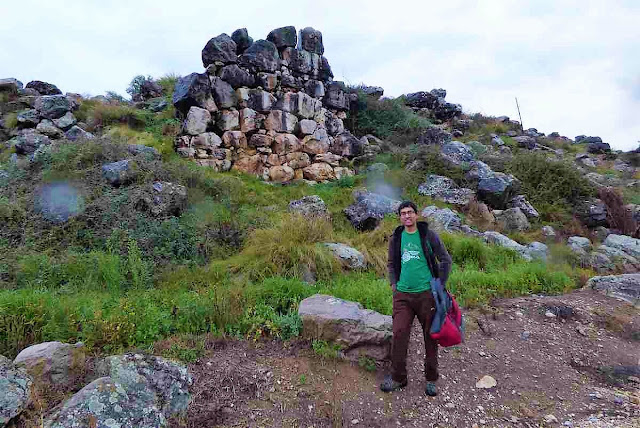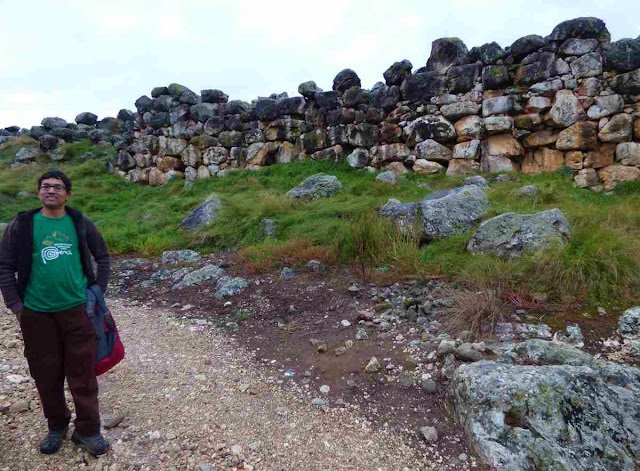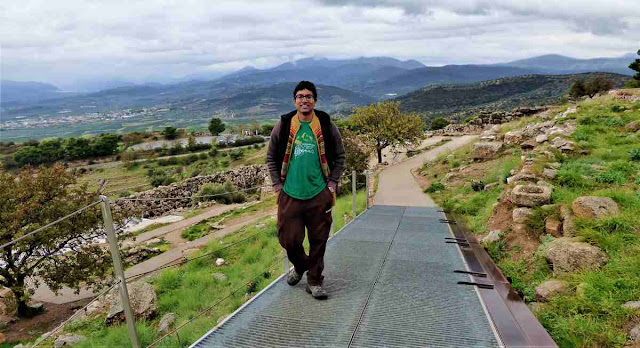Day 9, Nov 17, 2018, Saturday:
We brought our car from the port,
loaded it up with our luggage. Then left the keys inside our room,
pulled the door shut and then walked out of the house pulling the
staircase door also shut as instructed.
Storm warning was in place, rain
predicted even in Athens. There was a drop or 2 of rain as we started
off by 7.30 am.
Here's a good map of Peloponnese:
This was our route with detours to the archaeological sites:
We reached Tiryns archaelogical site at 8 am and the official opened the gates for us.
Here's a good map of Peloponnese:
This was our route with detours to the archaeological sites:
We reached Tiryns archaelogical site at 8 am and the official opened the gates for us.
TIRYNS:
Tiryns was a hill fort with occupation
ranging back seven thousand years, from before the beginning of
the Bronze Age. It reached its height between 1400 and 1200 BCE.
It is the location from which mythical hero Heracles performed
his 12 labors.
Its most notable features were its palace,
its Cyclopean tunnels and especially its wall. Ancient
tradition held that the walls were built by the Cyclopes
because only giants of superhuman strength could have lifted the
enormous stones.
After viewing the walls of the ruined citadel in the
2nd century CE, geographer Pausanias wrote that two
mules pulling together could not move even the smaller stones.
There was a slight drizzle, we walked
around with an umbrella, admired the walls.
Tried to go round the
other side, but a dog on a farm barked furiously. Son noticed that
the dog can easily run thru the fence and come to us. We attempted
twice, but the dog did not let up. We walked back to our car and
drove on.
Mycenae:
Reached Mycenae. I've written in
detail about dog trouble at the entrance and inside in the intro. I
took the umbrella and poncho but there was no rain, in fact there was
no rain for the rest of the day and we were able to enjoy all the
sites we had scheduled.
In 2000 BC, Mycenae was one of the
major centers of Greek civilization, a military stronghold
Mycenae, an acropolis site, was built on a hill 900 feet
above sea level. it easily overlooked the whole area and was ideally
positioned to be a centre of power, especially as it commanded all
easy routes to the Isthmus of Corinth. Besides its strong
defensive and strategic position, it had good farmland and an
adequate water supply. The period of Greek history from
about 1600 BC to about 1100 BC is called Mycenaean in
reference to Mycenae. At its peak in 1350 BC, the citadel and
lower town had a population of 30,000 . By 1200 BC, the power of
Mycenae declined.
We admired The Lion Gate;
two lionesses or lions flank the central column.
The whole
site was lovely and commanded impressive views. I was so glad I had not turned back because of the dogs and skipped this wonderful site
Museum was nice too.
Escaped the dogs
and got into our car and drove on.
VIDEO LINK:
Our video of Epidaurus amphitheater, museum, Tiryns, Mycenae:
Our video of Ancient Nemea and Akrocorinth is here:
Part 2 of this day's report with Nemea, Acrocorinth continues here:

















































No comments:
Post a Comment